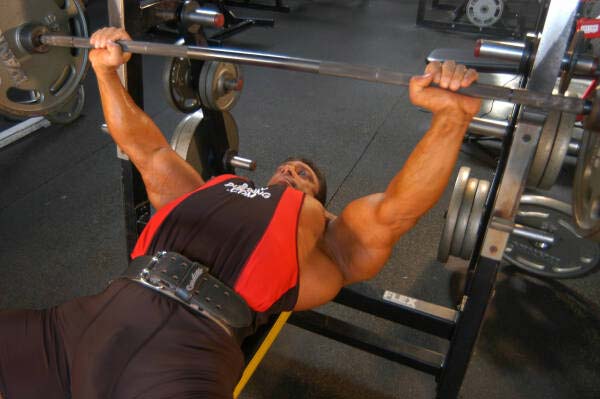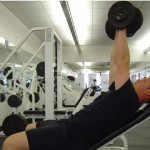Ah, the bench press. Is there an exercise that is more popular? Doubtful. After all, what is the first thing everybody who doesn’t lift (and many of those that do) ask you when you tell them you’ve been hitting the gym? It’s engrained in all of our heads, for better or worse: “So, how much do you bench press?” It’s that defining moment when you’re faced with a decision: do you throw out your real number or do you, like many, feel the flow of insecurity and inadequateness flow through your veins as you excitedly exclaim you bench press much more than you actually do? Fortunately, you won’t have to resort to the “misrepresentation” that is option 2 for too much longer (assuming you did, of course). After several popular chest articles, notably How To Get a Bigger Chest and Increase Your Chest Size, it’s time to conquer the bench press specifically. Whether you’re simply in it to boast about your numbers, or you’re focused on growing that chest (or both), understanding what is necessary to achieve proper bench press form + incorporating a bench press-focused routine are essential to separating yourself from the pack. Listen and learn, the Bench Press Workout:
1. Form
Before we begin, there’s something very important that needs to be stressed here. First and foremost, unless you are suffering from a shoulder injury (or any other injury), you are from this day forth barred from lowering the weight only to parallel or higher. In other words, touch your chest on each rep (or stop right before you’re about to touch the bar with your chest). Too often individuals are trying to show off and seem “cool” only to forget the entire purpose of why they are bench pressing: you’re there because you’re trying to grow your chest. Because your chest is the focus, you have to account for proper range of motion (ROM) and come to understand that at different points in your ROM different muscle groups take over. In short, from your chest to about parallel, your chest does a majority of the work. From parallel to lock out (when you straighten your elbows at the top), your triceps take over.
Now, tell me what all those individuals going a quarter to half of the way down accomplish exactly? Sure, they’ll work their chest. But will they work it optimally? No. They’re focusing on the tricep-heavy portion of the movement to boost their egos by loading up more weight. Remember, it’s about destroying the targeted muscle group. Full range of motion reps will accomplish this. In fact, you’re encouraged to incorporate the concept of constant tension and forget lock out altogether. By the way, the same can be said if you bench press just to boost your numbers, because let’s be real, your half reps won’t count anyway.
For the information that follows, we have a special contributor. Welcome Fabian Sybille, the man in the video and contributor to the information below that’ll set you apart from the pack:
a. Hand Spacing – You want to make sure your forearms are as vertical as possible at the bottom of the lift. That way, all the force you produce will push the bar as straight up as possible. If your hands are too far apart, the force you produce will go outward. If your hands are too close, the force you produce will go inward. Strike the right balance.
b. Legs and feet – You want to use your legs to help you push the weight. You do that by driving your legs into the ground. You can’t do that if your legs are on the bench or moving all crazy like the majority of people do when it gets heavy. Your legs should be planted and have a little more than a 90 degree bend in them. Have you ever noticed people struggling at the end of a set with their legs dangling around? They’re not firmly planted, so they limit themselves because the drive they could have just isn’t there. Remember, just because the bench press targets a specific body part or two doesn’t mean other body parts don’t matter in the movement.
c. Back and Shoulders -Your back is essentially the launching pad for the bench press. It’s very important for the negative phase of the exercise. It’s the center of support. You need to have a strong back, with tensed lats (yes, lats). Also, you should try to bring your shoulder blades together as much as you can. When your shoulders are not rolled back and brought in they will come too much into the movement at risk of both injury and lack of the necessary drive to boost efficiency and weight lifted.
d. Breathing – Do not hold your breath (this applies to every exercise)! You’re only making it harder for yourself when it comes to producing force. So many people hold their breath while trying to push big weight. If you blow out, it is almost guaranteed it’ll help you push the weight up.There’s been many times I’ve been under heavy weight and was close to not getting that last rep. I just kept blowing out and the bar slowly inched its way up to the top. In short, breathe in on the way down and breathe out on the way up.
Here’s a few other things to think about when trying to get a stronger bench press:
2. Routine:
Don’t do the same routine just because you’re used to doing it. You’re used to doing the same amount of reps and weight. You won’t get anywhere doing the same thing. Again, it’s about progressive overload. You won’t achieve this if do not track your progress from day to day and improve in some way. Never settle for accomplishing only what you accomplished last workout session!
3. Train accordingly:
I can’t tell you how many people see me lift and say they want to get as strong as me and I ask them how they train. They always train like a bodybuilder. You won’t get powerlifter strength by training like a bodybuilder. With that being said, I don’t look as good as a bodybuilder does because I train like a powerlifter. So, weigh what is most important to you.
4. Nutrition:
If you put [something equivalent to a "number two"] into your body, you’re not going to reach your full potential. It’s as simple as that. There’s plenty of articles on here about nutrition, get to it. Maximize how your body functions.
5. Doubt:
A lot of people never hit big weight because they never attempt it. I’m never afraid to try big weight, or a weight that’s at least slightly heavier than what I normally do. How are you going to know that you’re stronger, if you don’t try to lift heavier weight? This is a killer for many people because the weight intimidates them, but it should be the other way around. Get under that bar when bench pressing like you want to blow that bar into the ceiling. Confidence is key to success in anything, it is no different here. Intimidation leads to hesitation, hesitation leads to failure! Gym Motivation.
Finally, if you want to improve your bench press the most obvious and important component is bench pressing more often. I do this workout three days a week. First there is a heavy day, then a light day, and finally a medium day. A heavy day, light day, then a medium. It’s all designed to improve bench power.
Monday – (Heavy Day)
After a proper warmup:
Bench Press -> 3 sets of 5-7 reps, 3 sets of 3 reps, 1 set of 5 reps.
Should Press -> 4 sets of 5-7 reps
Bent Over Row -> 4 sets of 5-7 reps
Skull Crushers -> 4 sets of 5-7 reps
Barbell Curls -> 4 sets of 5-7 reps
Wednesday – (Light Day)
After a proper warmup:
Bench Press -> 4 sets of 5-7 reps
Incline DB Press -> 3 sets of 8-10 reps
Front DB Raises/Plate Raises -> 3 sets of 8-10 reps
DB Rows -> 3 sets of 8-10 reps
Tri Pushdown -> 3 sets of 8-10 reps
Preacher Curl -> 3 sets of 8-10 reps
Friday – (Medium Day)
After a proper warmup:
Bench Press -> 5 sets of 5-7 reps
DB Military Press -> 4 sets of 5-7 reps
Lat pulldowns -> 4 sets of 5-7 reps
Dips -> 4 sets of 5-7 reps
Alternate DB Curls -> 4 sets of 5-7 reps
Most importantly, every time you’re able to complete your heavy day bench press workout, go up 5lbs on the bench on every day. Do not try to rush it, experiment with shorter rest periods and slower negatives if you want to add variety to help achieve progressive overload. For more on workout routines, visit our German Volume Training article and our Best Routine article. Own that bench, it’s yours for the taking. Good luck!







